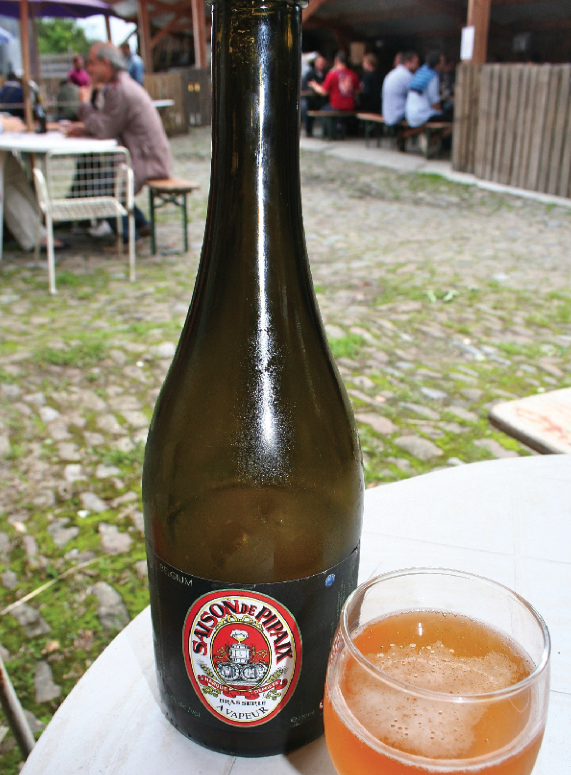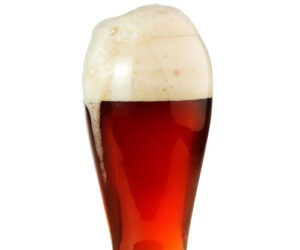Saison for All Seasons

Saison is often called a farmhouse ale, clearly identifying its roots as a locally-brewed beer for field workers, and evoking images of a rustic beer produced by small artisan farmer-brewers. That image is likely to be overly romanticized; the beer was brewed very locally at a farm, village or local collective, and designed to quench and refresh field workers. It had a rustic character due to primitive malting and the use of adjuncts and local farm-produced ingredients. As with most styles, it has evolved and expanded over time. Production of saison grew and consolidated as the need for local beer production was reduced with mechanization on the farm, and had mostly transitioned to larger breweries after World War II.
The style was originally a lower-alcohol product so as to not debilitate field workers, but tavern-strength products also existed. Higher strength and different-colored products began appearing after World War II, when the style was expanding into new markets. Dupont’s Moinette, a “super saison” of 8.5% strength, was first produced in 1954 and is its flagship product in Belgium. A brown version (Moinette Brune) was first produced in the mid-1980s. Brasserie Fantôme began production in 1988, and has products evocative of the four seasons: Hiver (winter), Printemps (spring), Été (summer) and Automne (fall).
The best known modern saison is Saison Dupont Vieille Provision (old stock), a 6.5% ABV saison d’été (summer saison) first brewed at Brasserie Dupont in Tourpes in the 1920s. Simply known to most people as Saison Dupont, this beer is widely available in the US and serves as the prototype for the current Beer Judge Certification Program (BJCP) Style Guidelines definition of the style. Dupont produces saisons in a wide range of strengths. A lower-strength version, known as Biolégère (organic), weighs in at 3.5% ABV and is perhaps the closest modern version of the historic farm beverages. Not to be outdone, Dupont also brews a higher-strength limited edition 9.5% holiday version known as Avec les Bons Voeux de la Brasserie (with the best wishes of the brewery) — a personal favorite of mine.
As with most Belgian styles, saisons are not typically spiced, with brewers preferring to let the yeast, hops, and grains provide the character. But there are several well-known examples that do feature spicing or unusual ingredients. Brasserie à Vapeur Saison de Pipaix is probably the best known spiced version, featuring black pepper as a dominant flavor among other qualities. Brasserie de Blaugies Saison d’Epeautre uses spelt as a grain, but wheat, oats, rye and other cereal grains are also common ingredients in saison recipes.
This is a style that has not escaped the attention of American craft brewers, especially those that produce other Belgian-influenced beers.
Southampton, Lost Abbey, The Bruery, Jolly Pumpkin and Ommegang are fairly well-known producers, but many others may be giving the style a try. Expect American producers to be more experimental, so stash your style expectations for a while and see how the products taste. (Read more about American saisons in the July-August 2011 issue of Brew Your Own.) American producers might produce examples with more or different ingredients, often using Brettanomyces in the production, and can push the envelope with different colors, strengths and ingredients. Remember, regardless of the brewer’s interpretation, the resulting product should be refreshing, interesting and drinkable. Excessive spice additions, overly sweet versions or massively funky interpretations showing more brashness than finesse are likely to be momentarily interesting but not worth revisiting.
Attributes of Modern Saison
Given that modern interpretations of saison can vary in strength from 3.5% to 9.5% ABV, and in color from pale yellow to black, it is hard to write a single style description that encompasses the entire range. It’s best to think of saisons as a family of styles, with the normal saison being in the 5.5% to 6.5% range, table versions of less than 5%, and super saisons of 8% and greater. The stronger versions are more likely to have color variations, while the table and normal strength versions are typically pale. Pale versions are likely to have more bitterness and a greater hop character, while darker versions tend to have more malt character and sweetness, yielding a more balanced presentation. Stronger versions often will have more malt flavor, richness and body simply due to their higher gravity. Although they tend to be well-attenuated, they may not be perceived to be as dry as normal-strength saisons due to their strength.
The normal saison can best be defined as a refreshing, highly-attenuated, moderately-bitter (20–35 IBUs), moderate strength (5.5–6.5%) Belgian ale with a dry finish. Most are highly carbonated (and bottle conditioned) as well as unfiltered. They often make use of non-barley cereal grains, may optionally use spices (always with moderation), and feature an expressive yeast character that is fruity, spicy and not overly phenolic. Sourness is totally optional, and may substitute somewhat for bitterness. Spices tend to be more peppery than clove-like, while the fruity esters can take on an apple, pear, apricot or citrus character. The hop bitterness can be restrained, although it can seem accentuated due to the high attenuation levels. The bitterness can have a harsh or coarse character due to water that is higher in carbonates and sulfates. The color tends towards gold to amber-orange. Overall, most will have a wild or rustic character that makes one think of terroir (a word used by winemakers to describe the geography, climate, growing conditions and even culture of a region that produces the special character of a product).
The other saisons in the family tend to have similar characteristics and balance, in particular the refreshing, highly-attenuated, dry character with high carbonation. The balance can change somewhat with strength and color variations, as I mentioned earlier, but the family resemblance of a farmhouse ale should be evident. The Saison yeast character is a must, although maltier and richer versions will tend to mask this character more.
Homebrewing Saisons
While researching homebrewed saison recipes, I turned to a few guys whose beers I had tasted, who had won recent awards, or who I knew to be excellent brewers: Steve Fletty of St. Paul, Minnesota, Brian Jackson of Cincinnati, Ohio and Nathan Smith of San Leandro, California.
Steve Fletty won Best of Show at the 2012 Minnesota State Fair (620 entries) with a winter-style Dark Saison. I’ve enjoyed Steve’s saisons for years, and he’s my go-to guy for saison questions. I remember several years ago doing a side-by-side tasting of the same saison recipe with different cereal grain adjuncts, as well as different yeasts. He prefers the Wyeast 3726 (Farmhouse Ale) yeast (Blaugies strain), but also likes the Wyeast 3711 (French Saison) yeast. He says the Dupont yeast can be finicky and unpredictable, even if fermented very hot, and often won’t completely attenuate. He has also tried different seasonal strains, but keeps coming back to the Blaugies yeast. He has recently been experimenting with different fermentation temperatures to see if the hot (85 °F/29 °C) recommendations are required for yeast other than the Dupont strain. So far, he observes that the 3726 and 3711 yeast seem to perform as well at normal (68 °F/20 °C) temperatures as at the elevated temperatures. Time to call MythBusters?
Steve is quite opinionated about Saisons (having made more than 20 of them), and wanted to stress that “farmhouse” does not mean “barnyard” — Brettanomyces isn’t required. “A Saison shouldn’t taste like Orval,” he said. Brett can add interest and help dry out the beer, but it shouldn’t be a dominant character; he recommends B. lambicus if it must be used. He has tried wheat, spelt, naked oats and rye as specialty grains but prefers rye and wheat the best. Various sugars and honeys can be used to lighten the body and increase attenuation, but he doesn’t like to use spices, preferring to let the yeast do the talking. He cites Phil Markowski’s book Farmhouse Ales as his primary inspiration, but has tasted every commercial saison he can find to help with his recipe targets.
As for fall and winter saisons, Steve recommends getting more body, avoiding roasty flavors and toning down the hops accordingly. While his recipe uses dark candy sugar for color and flavor, I would think that Munich, Vienna, CaraMunich®, CaraVienne® and similar grains would also add complexity and character, similar to what might be found in a Belgian dubbel. Many Belgian Christmas-type beers are spiced, so I would think orange peel, star anise, black pepper and similar warming spices might be interesting additions.
Steve recommends starting lower in gravity so that a low final gravity can be obtained. Even with a high attenuation, a lower final gravity is important to get that dry mouthfeel. He doesn’t think saisons should be noticeably alcoholic (“If dried out properly, you don’t need it”). He says the biggest faults he sees as a judge are beers that are flabby, overly spiced, boozy and filled with Brett flavors, when they should be clean, refreshing, dry and hoppy.
Brian Jackson won Best of Show at the 2012 Beer & Sweat competition (261 entries, keg-only) with The Awakening, a saison with ginger. His biggest recommendations for the style involves attenuation: step mashing with a low conversion temperature and no mash out to get maximum wort fermentability, aided by a sugar addition. He also selected the French Saison yeast to avoid issues with the finicky Dupont strain. He kept his malt and hops simple, looking for some character in the base beer to allow aromatics and flavor to be better featured. He cites Stan Hieronymus’ Brew Like a Monk and also Farmhouse Ales as primary references.
Nathan Smith, a multiple National Homebrew Competition medalist and my primary resource for all things hoppy, caught my attention recently when he tweeted that he thought he had successfully cloned Dupont’s Avec Les Bons Voeux. He did a split batch with Wyeast 3724 and White Labs WLP565 (both reputed to be the Dupont yeast) to try to pick a favorite. Last time I spoke with him, he seemed to believe that blending the two might be the most interesting outcome, but I’d suspect that the beers will keep changing as they age. He provided some detailed tasting notes on the yeast differences:
“Wyeast 3724: More earthy, minty, slightly malty and ethanol-driven. Esters are like super ripe sweet pears. Esters are more one-dimensional, everything else multi-dimensional. Big, complex, evolving, with some classic Dupont complexity.”
“WLP565: More mixed fruit (ripe plum, bosc pear) and hop-driven. Seems much drier even though has similar stats. Multi-dimensional esters, more simplistic malt, hops and ethanol. Big and direct, like a cross between Dupont and Westmalle yeast.”
Those are very interesting tasting notes; I’d love to see them again when the beer is a year old. Nathan recommends using fermwraps to maintain the high fermentation temperature. He also used third-generation re-pitches of his yeast from successively higher ABV saisons (3.5% and 6.2%). He recommends not even trying to taste the beer until after it has finished cold conditioning. Patience, grasshopper . . . provision beers aren’t meant to be consumed immediately.
These guys have shared four recipes with me, representing many different variations of the style, using different techniques and ingredients. Feel free to play with the recipes (starting on page 36) and vary the ingredients based on what I’ve discussed in this article — saison is a style that invites experimentation.
Rye Saison
by Steve Fletty,
St. Paul, Minnesota
(5 gallons/19 L, all-grain)
OG = 1.056 FG = 1.008
IBU = 31 SRM = 5 ABV = 6.3%
Ingredients
9 lb. 11 oz. (4.4 kg) US 6-row malt1 lb. 11 oz (765 g) flaked rye
9 oz. (0.26 kg) Turbinado sugar
7.3 AAU Nugget hops (60 min.) (0.56 oz./16 g of 13% alpha acids)
2.2 AAU Amarillo® hops (15 min.) (0.25 oz./7 g of 8.9% alpha acids)
2.4 AAU Centennial hops (15 min.) (0.25 oz./7 g of 9.5% alpha acids)
0.5 oz. (14 g) Amarillo® hops (0 min.)
0.5 oz. (14 g) Centennial hops (0 min.)
Wyeast 3726 (Farmhouse Ale) yeast (1-qt./1-L yeast starter)
1 cup corn sugar (for priming)
Step by Step
Two or three days before brew day, make the yeast starter, aerating the wort thoroughly (preferably with oxygen) before pitching the yeast. On brew day, mash in the malt and rye at 149 °F (65 °C) in 15 qts. (14 L) of water. Hold at this temperature for 60 minutes. Raise the mash temperature to 170 °F (77 °C), hold for 5 minutes then recirculate. Run off the wort and sparge with water hot enough to keep the grain bed around 170 °F (77 °C). Collect 6.5 gallons (25 L) of wort. (Check that final runnings do not drop below SG 1.010.) Boil the wort for 90 minutes, adding hops at times indicated in the ingredients list. Add the sugar at the end of the boil, stirring to dissolve.
Chill the wort, transfer it to a fermenter and pitch the yeast. Ferment at 85 °F (29 °C). Bottle condition.
Variation: Substitute flaked wheat for rye; substitute Styrian Goldings for Amarillo® and Centennial.
Rye Saison
by Steve Fletty,
St. Paul, Minnesota
(5 gallons/19 L, partial mash)
OG = 1.056 FG = 1.008
IBU = 31 SRM = 5 ABV = 6.5%
Ingredients
2 lb. 3 oz. (1 kg) US 6-row malt
1 lb 11 oz. (0.77 kg) flaked rye
1.25 lbs. (0.57 kg) light dried malt extract
3.3 lbs. (1.5 kg) light liquid malt extract
9 oz. (0.26 kg) Turbinado sugar
7.3 AAU Nugget hops (60 min.) (0.56 oz./16 g of 13% alpha acids)
2.2 AAU Amarillo® hops (15 min.) (0.25 oz./7 g of 8.9% alpha acids)
2.4 AAU Centennial hops (15 min.) (0.25 oz./7 g of 9.5% alpha acids)
0.5 oz. (14 g) Amarillo® hops (0 min.)
0.5 oz. (14 g) Centennial hops (0 min.)
Wyeast 3726 (Farmhouse Ale) yeast (1-qt./1-L yeast starter)
1 cup corn sugar (for priming)
Step by Step
Mash the grains at 149 °F (65 °C) in 6 qts. (5.6 L) of water. Hold at this temperature for 60 minutes. Collect 2.25 gallons (8.5 L) of wort. Add water to make at least 3 gallons (11 L) of wort. Stir in the dried malt extract and boil the wort for 90 minutes, adding hops at times indicated. Add liquid malt extract and sugar in the final 15 minutes of the boil. Chill the wort, transfer it to a fermenter and top up to 5 gallons (19 L). Aerate the wort and pitch yeast. Ferment at 85 °F (29 °C). Bottle condition.
Rye Saison
by Steve Fletty,
St. Paul, Minnesota
(5 gallons/19 L, extract)
OG = 1.057 FG = 1.008
IBU = 40 SRM = 5 ABV = 6.5%
Ingredients
1 lb. (0.45 kg) liquid rye malt extract
2.25 lbs. (1 kg) light dried malt extract
3.3 lbs. (1.5 kg) light liquid malt extract
9 oz. (0.26 kg) Turbinado sugar
7.3 AAU Nugget hops (60 min.) (0.56 oz./16 g of 13% alpha acids)
2.2 AAU Amarillo® hops (15 min.) (0.25 oz./7 g of 8.9% alpha acids)
2.4 AAU Centennial hops (15 min.) (0.25 oz./7 g of 9.5% alpha acids)
0.5 oz. (14 g) Amarillo® hops (0 min.)
0.5 oz. (14 g) Centennial hops (0 min.)
Wyeast 3726 (Farmhouse Ale) yeast (1-qt./1-L yeast starter)
1 cup corn sugar (for priming)
Step by Step
Add the dried malt extract and sugar to enough water to make at least 3 gallons (11 L) of wort. Boil wort for 90 minutes, adding hops at times indicated. Keep some boiling water handy and do not let the boil volume dip below 3 gallons (11 L). Add the liquid malt extract in the final 15 minutes of the boil. Chill the wort, transfer to fermenter and top up to 5 gallons (19 L). Aerate the wort and pitch the yeast. Ferment at 85 °F (29 °C). Bottle condition.
Variation: You may use liquid wheat malt extract in place of rye.
Tips for Success:
To hit the standard CO2 level for a typical Belgian beer (about 8 grams per liter), this recipe recommends one cup of sugar, which is a bit more than the typical 3⁄4 cup suggested by most homebrew experts in many recipes. Traditional Belgian yeast requires higher temperatures to condition efficiently, and most Belgian breweries have “warm rooms” for bottle conditioning that hold the temperature constant throughout the conditioning period. You can do this at home by bottle conditioning in a spot that is consistently around 78 °F (25 °C), which is above room temperature.



